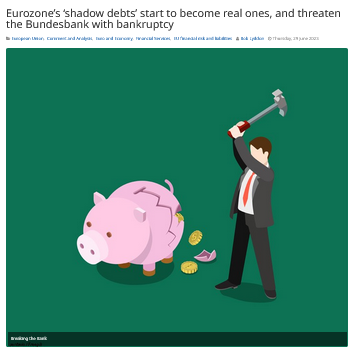Published on 7th July 2023
The German Federal Audit Office (‘Bundesrechnungshof’) has warned that the Bundesbank may need a bailout due to losses on the EUR650 billion of bonds it bought as part of the Eurozone’s equivalent of Quantitative Easing. The Daily Telegraph reported on this on 26 June.[1]
Of course the risk is not for the entire EUR650 billion but for the fraction by which the price of the bonds fell when interest rates rose, a fraction that could nevertheless exceed the Bundesbank’s capital and reserves.
This risk is one of the ones discussed in my book recently issued through The Bruges Group, ‘The shadow liabilities of EU Member States, and the threat they pose to global financial stability’.
Chapter 13 puts a figure against the risk: ‘Quantification of liabilities: market losses on ECB programmes’.
How the European Central Bank’s (‘ECB’s) bond-buying programmes have given rise to the risk is outlined in two chapters:
- Chapter 3.iv ECB Asset Purchase Programmes (APP); and
- Chapter 5.i The Pandemic Emergency Purchase Programme (PEPP).
The programmes amounted to EUR5.9 trillion at the end of 2021. The ECB does not itself buy the bonds, but has its offshoots – the Eurozone national central banks – buy the bonds issued in their countries. Only the Bundesbank buys German bonds, only the Banque de France buys French ones and so on.
Originally the make-up of the APP portfolio was in line with each Eurozone national central bank’s percentage share in the ECB, known as its ECB Capital Key, re-based to eliminate the shares of the non-Eurozone member states (including the Bank of England whilst the UK was an EU member).
By that token the Bundesbank, with a re-based ECB Capital Key of 26.3615%, should be owning EUR1.56 trillion of the overall EUR5.9 billion – if these programmes had been invested country-by-country in line with the ECB Capital Keys.
But the ECB has long since abandoned this rule and has tilted the make-up towards Southern European bonds.
Who bears the loss has not changed, though: it is shared around the Eurozone national central banks in accordance with ECB Capital Keys. Any profit or loss on an ECB operation is first passed back to the ECB by the Eurozone national central bank which incurred it, and then the ECB parcels the requisite portion of back out to each one, based on their ECB Capital Keys, including a portion to the one which incurred it.[2]
The Bundesbank is on-risk for up to 26.3615% of any such loss. Because of the tilted make-up of the EUR5.9 billion portfolio, the Bundesbank’s risk is on a much larger base amount than its direct holdings.
A simple model was used in the book to calculate the potential ‘market loss’: a 2% per annum rise in interest rates applied to bonds of a 7-year average maturity. That causes the bond’s price to drop by 14%. This translates into a loss of EUR826 billion on the EUR5.9 trillion of bonds held across the whole Eurosystem.[3] 26.3615% of that loss would be allocated to the Bundesbank, or EUR218 billion: EUR127 more than the loss on their direct holdings of EUR650 billion under the same parameters.
Either would bankrupt the Bundesbank, as the book makes clear. The German Federal Government would have to make good the amount from its budgetary reserves, or else issue new debt.
But the Bundesbank’s utterances fail to mention the loss-sharing mechanism…because they don’t know about it? Because it has been altered? Because it would increase their loss in this case? Because they intend to ignore it? Because they or the press have undercooked the numbers for political purposes?
Germany’s refuting the loss-sharing mechanism in the case of the APP and PEPP would confound the common assumption of capital markets about Eurozone liabilities: that they all track back onto Germany.
The possibility of member states refuting the loss-sharing mechanism is discussed in the book in relation to the TARGET2 balances in Appendix 4, and therein lies a major problem for Germany: in the case of TARGET2 the loss-sharing mechanism would work greatly in the Bundesbank’s favour. Without it they are on-risk for EUR1.2 trillion and possibly more, as Chapters 11 and 12 in the book lay out. With it, the amount-at-risk reduces below EUR500 billion, an advantage of EUR700 billion, dwarfing the disadvantage of accepting the application of the loss-sharing mechanism to the APP and PEPP.
The Bundesbank might like to have its cake and eat it, cherry-picking which ECB operations the loss-sharing mechanism applies to. This would be unrealistic: sauce for the goose is also sauce for the gander. The conclusion? The Eurozone has landed itself in a frightful Frankfurt mess, and its chickens are now coming home to roost.
[1] https://www.telegraph.co.uk/business/2023/06/26/german-central-bank-bailout-money-printing-spree/ accessed on 28 June 2023
[2] This mechanism operates like an ‘Organschaftsvertrag mit Gewinn- und Verlustabführung’ or ‘Corporation agreement with take-over of profit and loss’, as is common in Germany between major corporates like a BMW AG and its German subsidiaries. The ECB mechanism may even have been copied from it.
[3] Eurosystem – the European System of Central Banks, meaning the ECB and all of the EU’s national central banks. In this instance the losses are for the account of the Eurozone national central banks alone.

